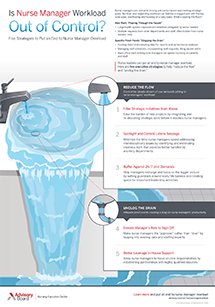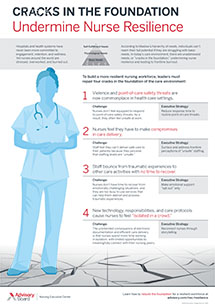Auto logout in seconds.
Continue LogoutThere is no national data on how many nurses die from suicide each year in the United States, but one expert says the lack of data doesn't mean nurse suicide isn't a problem—and outlines three ways nurse leaders can take action, Jennifer Thew reports for HealthLeaders Media.
Upcoming webconference series: Rebuild the foundation for a resilient workforce
A lack of data doesn't mean there's not a problem
Researchers estimate that about 300 to 400 physicians die from suicide annually in the United States, but—according to Judy Davidson, a nurse scientist at UC San Diego Health—researchers have not estimated the rate of suicides among nurses in the United States. Davidson said that lack of data shouldn't be interpreted as an indicator that suicide is not a problem among nurses.
Davidson explained, "We had nurse suicides in our own workforce and when we started talking to people, we found that many knew someone who had a nurse suicide in their organization. So, it wasn't just us." But, she continued, "[W]hen we went to the literature, there was no accounting for nurse suicide at a national level."
Davidson said, "My hunch is, if every organization only has one (suicide), you don't think of it as a problem," but when those are added up together, an organization might realize how much of a problem suicide is among nurses. "It really brings up the concrete message that we cannot hide this. The more we talk about it the more lives we can save," she said.
How to prevent nurse suicides
According to HealthLeaders Media, there are three steps nurse leaders can take to help prevent suicides among nurses:
1. Screen nurses.
UC San Diego Health piloted a program to screen nurses for burnout, depression, and potential suicide risks after more than one suicide occurred among nurses at the health system, HealthLeaders Media reports. The pilot program expanded the health system's Healer Education, Assessment and Referral (HEAR) program—which previously had solely focused on physicians—to include nurses.
For example, officials tailored the HEAR program's one-hour sessions on the risks of burnout, depression, and suicide to be geared toward nurses. The sessions include a personal account from a nurse who experienced suicidal ideation.
After the sessions, the chief nursing officer invited nurses to participate in an anonymous online screening—which, Davidson said, uses patient health questionnaire-9 (PHQ-9) and other questions—to predict suicide risk. A counselor then evaluates the screenings and contacts nurses considered to be at high risk for suicide, and invites them to come for counseling.
A study published in February in the Journal of Nursing Administration showed that, during the pilot's first six months, 172 of the health system's 2,475 nurses completed the questionnaire. Among those nurses, 55% were deemed to be at moderate risk for suicide, and 43% were at high risk. According to the study:
- 44 nurses received either in-person or verbal counseling;
- 19 nurses reported previous suicide attempts; and
- 17 nurses accepted referrals for continued treatment.
2. Proactively counsel nurses after they face difficult situations.
Davidson said UC San Diego Health's HEAR counselors also serve as a crisis response team to proactively offer counseling to nurses after they experience difficult situations, such as an assault, a medical error, or an unexpected patient death. They first hold a group debriefing and then offer the nurses affected by the incident individual counseling—all of which "has been a big hit with … staff," Davidson said.
3. Understand and identify risk factors.
Nurses who participated in the study on the HEAR pilot in an open-ended comment section identified what they felt caused them stress. According to Davidson, the nurses listed "a combination of work and home stressors." She said, "There is some evidence in the literature that when you combine work and home stressors you're at higher risk of suicide than if you have just work or home stressors."
Examples of home stressors include:
- Academic stress;
- Childcare;
- Marital strain;
- Financial issues;
- Feeling a lack of purpose in life;
- Feeling grief;
- Loneliness after moving;
- Personal or family health issues; and
- Personal or family drug or alcohol misuse.
Examples of work stressors include:
- Changing departments;
- Emotional burden of patient care;
- Fear of harming patients;
- Feelings of incompetence;
- Feeling unappreciated at work;
- Lateral violence;
- Learning new skills or teaching others;
- Management issues;
- Staffing; and
- Work volume.
According to HealthLeaders Media, nurse leaders can and should address many of the stressors related to nurses' work. Davidson said, "As nurse leaders we can always work on issues of lateral violence and bullying. We can always work on the issues of staff feeling unheard or feeling like they don't belong. That's a very strong risk factor for suicide—feeling like you don't belong within your work group."
Davidson added that while nurse leaders might feel as though it is not within their domain to address home stressors, a nurse leader's acknowledgement of home stressors can have a significant effect on reducing suicide risk among nurses. Citing research published in the Journal of Nursing Management on emotions in the workplace, Davidson said nurses want to be seen as a "whole person" who is appreciated both professionally and personally—and feeling cared for at work helps drive nurses to engage in healthy behaviors. Davidson said, "Sometimes nurse leaders feel it's beyond their purview to recognize those home issues, or that it's not appropriate in the workplace, but I think from what we're finding out from these risk factors for suicide, nothing could be further from the truth. Nurses want to be recognized as whole people" (Thew, HealthLeaders Media, 6/12).
Upcoming webconference series: Rebuild the foundation for a resilient workforce
Hospitals and health systems have never been more committed to engagement, retention, and wellness. Yet, doctors and nurses around the world are stressed, overworked, and burned out.
In this three-part webconference series, learn about the unaddressed needs, or “cracks in the foundation,” undermining resilience and leading to burnout in today’s care environment.
Don't miss out on the latest Advisory Board insights
Create your free account to access 1 resource, including the latest research and webinars.
Want access without creating an account?
You have 1 free members-only resource remaining this month.
1 free members-only resources remaining
1 free members-only resources remaining
You've reached your limit of free insights
Become a member to access all of Advisory Board's resources, events, and experts
Never miss out on the latest innovative health care content tailored to you.
Benefits include:
You've reached your limit of free insights
Become a member to access all of Advisory Board's resources, events, and experts
Never miss out on the latest innovative health care content tailored to you.
Benefits include:
This content is available through your Curated Research partnership with Advisory Board. Click on ‘view this resource’ to read the full piece
Email ask@advisory.com to learn more
Click on ‘Become a Member’ to learn about the benefits of a Full-Access partnership with Advisory Board
Never miss out on the latest innovative health care content tailored to you.
Benefits Include:
This is for members only. Learn more.
Click on ‘Become a Member’ to learn about the benefits of a Full-Access partnership with Advisory Board
Never miss out on the latest innovative health care content tailored to you.


